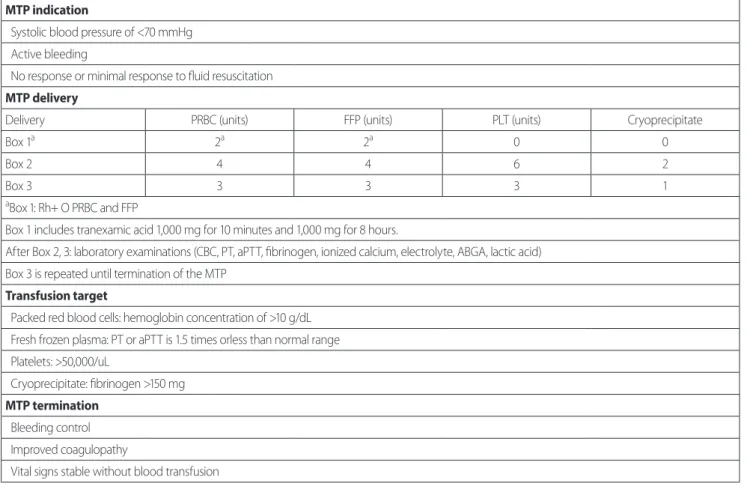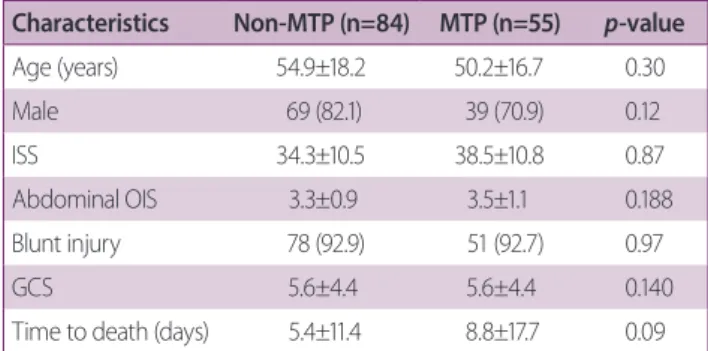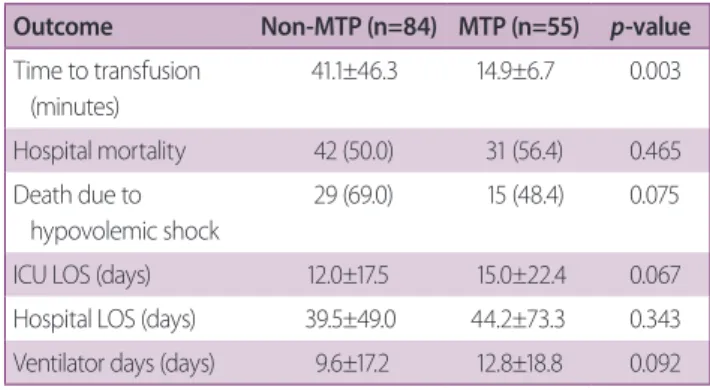Received: April 20, 2020 Revised: May 22, 2020 Accepted: June 11, 2020 Trauma and InJury
Correspondence to Sang Bong Lee, M.D.
Department of Trauma and Surgical Critical Care, Pusan National University Hospital, 179 Gudeok-ro, Seo-gu, Busan 49241, Korea
Tel: +82-51-240-7369 Fax: +82-51-247-7719 E-mail: scout79x@hanmail.net
http://www.jtraumainj.org Copyright © 2020 The Korean Society of Trauma
Effects of massive Transfusion
Protocol Implementation in Trauma Patients at a level I Trauma Center
Hyun Woo Sun, M.D., Sang Bong Lee, M.D., Sung Jin Park, M.D., Chan Ik Park, M.D., Jae Hun Kim, M.D.
Department of Trauma and Surgical Critical Care, Pusan National University Hospital, Busan, Korea
Purpose: This study was conducted to investigate whether rapid and efficient admin- istration of blood products was achieved and whether clinical outcomes were improved by applying a massive transfusion protocol (MTP).
methods: From January 2016 to September 2019, the medical records of trauma pa- tients who received at least 10 units of packed red blood cells (PRBC) at Pusan National University Hospital (level I trauma center) were retrospectively reviewed. The patients treated from January 2016 to January 2018 were designated as the non-MTP group, and those treated from February 2018 to September 2019 were designated as the MTP group.
results: During the study period, 370 patients received massive transfusions. The non-MTP and MTP groups comprised 84 and 55 patients, respectively. No significant between-group differences were found in the units of PRBC (23.2 vs. 25.3, respectively;
p=0.46), fresh frozen plasma (FFP) (21.1 vs. 24.4, respectively; p=0.40), and platelets (PLT) (15.4 vs. 17.0, respectively; p=0.54) administered in the first 24 hours. No statisti- cally significant differences between the non-MTP and MTP groups were found in the FFP-to-PRBC ratio (0.9 vs. 0.94, respectively; p=0.44) and or the PLT-to-PRBC ratio (0.72 vs. 0.72, respectively; p=0.21). However, the total number of cryoprecipitate units was significantly higher in the MTP group than in the non-MTP group (7.4 vs. 15.3 units, respectively; p=0.003) and the ratio of cryoprecipitate to PRBC in the MTP group was significantly higher than in the non-MTP group (0.31 vs. 0.62, respectively; p=0.021).
The time to transfusion was significantly reduced after MTP implementation (41.0 vs.
14.9 minutes, respectively; p=0.003).
Conclusions: Although no significant differences were found in the clinical outcomes of patients who had undergone severe trauma, rapid and balanced transfusion was achieved after implementing the MTP.
Keywords: Blood transfusion; Trauma centers; Retrospective studies
Effects of massive Transfusion
Protocol Implementation in Trauma Patients at a level I Trauma Center
Hyun Woo Sun, M.D., Sang Bong Lee, M.D., Sung Jin Park, M.D., Chan Ik Park, M.D., Jae Hun Kim, M.D.
Department of Trauma and Surgical Critical Care, Pusan National University Hospital, Busan, Korea
Purpose: This study was conducted to investigate whether rapid and efficient admin- istration of blood products was achieved and whether clinical outcomes were improved by applying a massive transfusion protocol (MTP).
methods: From January 2016 to September 2019, the medical records of trauma pa- tients who received at least 10 units of packed red blood cells (PRBC) at Pusan National University Hospital (level I trauma center) were retrospectively reviewed. The patients treated from January 2016 to January 2018 were designated as the non-MTP group, and those treated from February 2018 to September 2019 were designated as the MTP group.
results: During the study period, 370 patients received massive transfusions. The non-MTP and MTP groups comprised 84 and 55 patients, respectively. No significant between-group differences were found in the units of PRBC (23.2 vs. 25.3, respectively;
p=0.46), fresh frozen plasma (FFP) (21.1 vs. 24.4, respectively; p=0.40), and platelets (PLT) (15.4 vs. 17.0, respectively; p=0.54) administered in the first 24 hours. No statisti- cally significant differences between the non-MTP and MTP groups were found in the FFP-to-PRBC ratio (0.9 vs. 0.94, respectively; p=0.44) and or the PLT-to-PRBC ratio (0.72 vs. 0.72, respectively; p=0.21). However, the total number of cryoprecipitate units was significantly higher in the MTP group than in the non-MTP group (7.4 vs. 15.3 units, respectively; p=0.003) and the ratio of cryoprecipitate to PRBC in the MTP group was significantly higher than in the non-MTP group (0.31 vs. 0.62, respectively; p=0.021).
The time to transfusion was significantly reduced after MTP implementation (41.0 vs.
14.9 minutes, respectively; p=0.003).
Conclusions: Although no significant differences were found in the clinical outcomes of patients who had undergone severe trauma, rapid and balanced transfusion was achieved after implementing the MTP.
Keywords: Blood transfusion; Trauma centers; Retrospective studies
INTRODUCTION
Massive transfusion is commonly defined as a transfusion of more than 10 units of packed red blood cells (PRBC) in 24 hours [1-3]. Crystalloid solutions are commonly used during resuscitation of patients who have undergone trauma with hemorrhagic shock. However, the rapid ad- ministration of blood products is currently encouraged.
In addition, balanced transfusions of PRBC, fresh frozen plasma (FFP), and platelets (PLT) are known to improve coagulopathy caused by hemorrhagic shock. Several stud- ies have shown that administering PRBC, FFP, and PLT at a ratio of 1:1:1 or higher reduces mortality and improves treatment outcomes [4-6]. A massive transfusion protocol (MTP) is required for efficient massive transfusion, as it aims to rapidly and effectively deliver the blood prod- ucts that are necessary for trauma resuscitation. Many
trauma centers have implemented MTPs to deliver blood products, resulting in improved patient outcomes and mortality [7-9]. Accordingly, we also introduced a MTP in February 2018 and have applied it in the context of massive transfusions in severe trauma patients. The pur- pose of this study was to determine whether rapid and efficient administration of blood products was achieved by applying the MTP, and whether mortality and clinical outcomes were improved through this approach.
METHODS
The medical records of patients who received greater than 10 units of PRBC during the first 24 hours after present- ing to the emergency department of the trauma center of Pusan National University Hospital from January 2016 to
MTP indication
Systolic blood pressure of <70 mmHg Active bleeding
No response or minimal response to fluid resuscitation MTP delivery
Delivery PRBC (units) FFP (units) PLT (units) Cryoprecipitate
Box 1
a2
a2
a0 0
Box 2 4 4 6 2
Box 3 3 3 3 1
a


